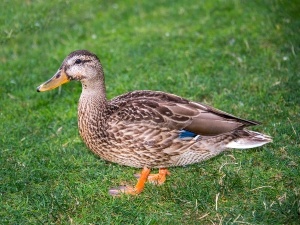
If given a well-rounded and healthy diet then your ducks should live a long and healthy life, however, certain diseases can cause these birds to become sick and die prematurely, these diseases include diseases of the feet
If you notice something wrong with your bird’s feet, if there are black spots on your duck’s foot, you’d be right to be concerned, this article looks into why this happens and what to do.
Table of Contents
Black spot on duck foot:
Any change in your bird’s appearance or behavior should ring your alarm bells, birds change how they act and look when something has changed with them. Here are the possible reasons why there are black spots on your duck’s foot:
Melanin:
If the spots on your bird’s feet are smooth on the skin then the black spots may simply be melanin.
Melanin is the brown pigment that is responsible for the dark color of our hair, skin, and iris of the eyes. When we tan melanin is what makes our skin darker.
Ducks have this pigment in their skin, on their feet and beaks, as well but it doesn’t show up because the pigment is covered by a yellow-colored pigment called xanthophyll.
Xanthophyll is present in feed ingredients like alfalfa, corn, and other feed ingredients. Other sources of this yellow-colored pigment include egg yolk, fat, skin, and green plants.
The birds will eat these foods and the yellow pigment will be abundant in their skin. However, when ducks start to lay eggs some of the yellow pigment is absorbed into the egg yolk that they produce removing it from their legs and beak
If the bird doesn’t eat more xanthophyll than is removed by the egg yolk, then the dark spots will start to show up on the bird’s feet and even on their bills
What to do:
The presence of these dark spots only means that the bird is lacking in this yellow-colored pigment, it isn’t something to worry about and is easily remedied.
Give the bird foods rich in xanthophyll, especially when it’s laying eggs. The bird’s feet should go back to looking as normal once the xanthophyll levels in the bird’s body are replenished.
Calluses:
If the black spots on your bird’s feet are thick, and hard, and there is more than one, then your bird may have calluses under its foot.
Duck feet are more fragile than we know, the birds are used to walking around in wet areas and swimming in water bodies in the wild.
However, if the birds on your property are walking around on hard surfaces, like concrete, then the bird may develop calluses under their feet.
The skin on the bird’s feet will try to protect the feet by thickening up where friction and pressure are applied resulting in calluses.
What to do:
The calluses help to keep the bird’s feet protected from hard floors which is good for the bird, but, if the calluses start to crack then an infection can develop on the bird’s feet.
You can get rid of the calluses by massaging petroleum jelly into the bird’s feet every 12 hours for a couple of days, the calluses will soften up eventually and go away on their own
It’s important to note that if you don’t offer softer flooring for the bird’s feet after the petroleum jelly treatment then the calluses can develop again.
Giving the birds access to water bodies to swim in, and padding the floors that your ducks walk on with a soft material, will keep the feet from developing calluses again.
Bumblefoot:
If your bird has one black spot under its foot, and there is a lump under the black spot, then the bird may have bumblefoot.
Bumblefoot, also called a staph infection, is more common in heavier ducks like Appleyard or Perkin ducks, but any breed of duck can develop bumblefoot.
If your bird becomes injured at its foot, if a splinter gets into the bird’s foot, or if the bird’s foot gets cut somehow, and bacteria get into the foot then an infection can develop.
The area will form a swollen lump, the swollen lump is a hard pus-filled lump and a scab will cover the site of the injury. This is bumblefoot.
A bird with bumblefoot may also limp, have the reluctance to walk, there will be redness at the bird’s feet and the bird will generally be unwell.
What to do:
You can choose to lance the bird’s lump at home but you would need to give the bird antibiotics to keep the infection in check, thus it is recommended that you take the bird to the vet to lance the lump and remove the pus.
If the bumblefoot is not too severe, then keeping the bird’s feet sanitized, creating a comfortable environment for the bird to heal in, and giving the bird anti-inflammatory medication as well as oral and topical antibiotics will help.
If you enjoyed this article then you may also be interested in other chicken related articles. Here are some articles that you may be interested in: Pigeon-Toed Duck, Bow-Legged Duckling, Beak Rot In Ducks, Callus On Duck’s Foot, Black Spots On Duck Bill,

